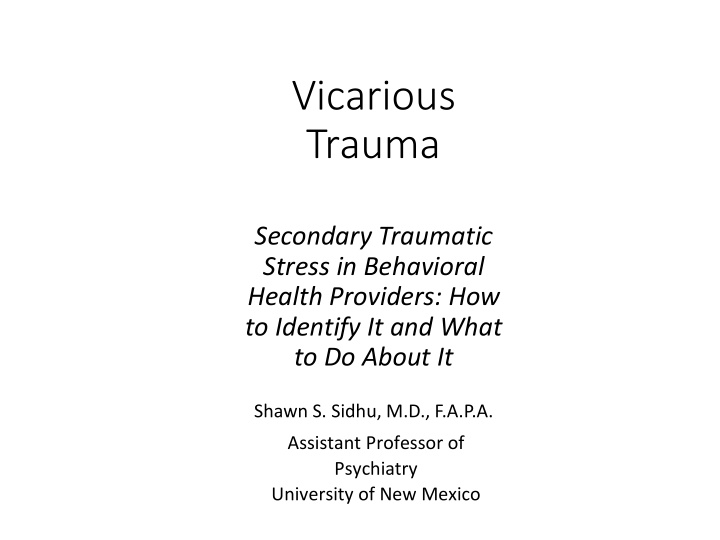



Vicarious Trauma Secondary Traumatic Stress in Behavioral Health Providers: How to Identify It and What to Do About It Shawn S. Sidhu, M.D., F.A.P.A. Assistant Professor of Psychiatry University of New Mexico
DISCLOSURE SLIDE Shawn S. Sidhu writes Continuing Medical Education questions for the American Psychiatric Association journal FOCUS for which he receives royalties
Objectives At the end of this presentation, participants will be able to: 1. Identify signs of compassion fatigue and burnout in themselves and colleagues. 2. Create an action plan to prevent compassion fatigue and burnout from occurring. 3. Create a treatment plan for compassion fatigue and burnout once identified.
Main References “ Understanding Compassion Fatigue in Healthcare Providers: A Review of Current Literature.” Journal of Nursing Scholarship . 2016 Jun 28 [Epub ahead of print]
Impact of Vicarious Trauma on Work Performance and Satisfaction
What is Vicarious Trauma? Other similar concepts include “Secondary Traumatic Stress” and “Compassion Fatigue” Vicarious Trauma refers to the process by which behavioral health workers are exposed to the traumatic stories and experiences of their patients/clients
Secondary Traumatic Stress Exposure to vicarious trauma which causes distress and could result in impairment in functioning, as would be expected in such conditions as Post-Traumatic Stress Disorder (PTSD) and Acute Stress Disorder (ASD)
Compassion Fatigue “Exposure to repeated interactions requiring high levels of empathic engagement with distressed clients (not necessarily trauma) ” Physical, emotional, and work-related symptoms Impairs Functioning (ability to care for self and others)
Compassion Fatigue Can be a PRECURSOR to burnout
Burnout (1) High Levels of Emotional Exhaustion, (2) High Levels of Depersonalization, and (3) Low Levels of Personal Accomplishment.
Signs/Symptoms of Secondary Traumatic Stress Being unable to get stories or images out of your mind after the session is over, including possibly nightmares or flashbacks Feeling hypervigilant or like your own safety could be endangered Feeling restless, keyed up, or on edge Avoiding certain situations Noticing an impact on mood or functioning
How Common is Secondary Traumatic Stress? The vast majority of nurses working in emergency departments reported traumatic stress within the past week At least 33% of this sample met full criteria for Secondary Traumatic Stress (Dominguez-Gomez and Rutledge 2009) 72% of trauma workers endorsed working with their own trauma therapist as “necessary or often justified” (Deighton et al. 2007)
Signs/Symptoms of Compassion Fatigue Having greater difficulty maintaining the same degree of empathy over time Feeling numb, detached, or indifferent Feeling mentally, physically, and emotionally exhausted Ultimately feeling powerless or like a failure
How Common is Compassion Fatigue and/or Burnout? 69% of physicians in Australia met criteria for burnout and 71% have a concern for their own health and well-being. 30% reported emotional exhaustion (Markwell and Wainer 2009) 50% of child protective services workers experience high or very high levels of compassion fatigue (Conrad and Kellar-Guenther 2006) 25-70% of medical interns report burnout (surgery highest)
Impact of Vicarious Trauma on Personal Health and Well-Being What Makes Us Good Doctors May Hurt Us as Individuals
What Makes Us Vulnerable as Health Professionals? Culture of: • Perfectionistic and Self-Sacrificial Altruism • High Standards of Achievement, Delayed Gratification • Multiple Generations of Physicians (multiple duty hour changes) • Resistance to Seeking Self-Care • “Disease Model” - recognizing something when it becomes a measureable problem, which is antithetical to prevention/wellness
Mental Health Impact of Burnout on Physicians 30% of medical students suffer from depression ( JAMA ) Up to 30% of residents have depression *Psychiatrists have the highest rates of depression among physicians. *Specifically up to 73% of female Psychiatrists report a history of depression compared to 46% of other female physicians
Suicide Suicide rate in male physicians is 40% higher than national average Suicide rate in female physicians is 130% higher than national average
Substance Abuse 33% of medical students meet criteria for alcohol abuse/dependence 10 to 12% of physicians develop a substance use disorder at some point during their careers (14-26% of surgeons)
Divorce 24% lifetime divorce rate (actually lower than national average 40- 50%) *Psychiatrists 51%, Surgeons 33%, 20-30% for all other specialties 10-20% higher divorce rate than general public More likely to report unhappy marriages
What to Do About It In a meta-analysis of 42 articles, self-care was the most significant preventative measure Also helpful were finding effective emotional coping strategies and feeling a sense of control Workplace educational programs have helped to improve awareness and increase prevention, recognition, and treatment
Self-Care Talking to colleagues Night-Time Routine/Time Away from Work -Creative Outlets and Restorative Activities -Avoid Re-Traumatization/Toxic Relationships Regular Appointments (doctor, dentist, therapist, massage, chiropractor, etc.) Exercise/Diet/Sleep Religious/Spiritual Life
Vicarious Resilience and Vicarious Post- Traumatic Growth Edelkott N, Engstrom DW, Hernandez-Wolfe P, et al. “Vicarious Resilience: Complexities and Variations.” Work Environment: Teamwork and positive working relationships are preventive, whereas isolation and toxic relationships are a risk factor
Chiron Instructs Young Achilles
Carl Jung - The Wounded Healer Based on the myth of Chiron – who despite being a master of healing was unable to heal himself in the end 74% of counselors and therapists have experienced one or more “wounding experience” leading to their career path (Barr 2006) What to do with these wounds?
Quotes from Jung “The therapist is consciously aware of his or her own personal wounds. These wounds may be activated in certain situations especially if the patient’s wounds are similar to his or her own. In this case, the patient’s wounds affect the therapist. The therapist then either consciously or unconsciously passes this awareness back to the patient, causing an unconscious relationship to take place (Transference/Counter- Transference)” Jung mentioned the way to avoid this is the therapist having an awareness of his/her unconscious thoughts and behaviors
Quotes from Jung “ A good half of every therapeutic process that probes at all deeply consists in the doctor’s examining himself...it is his own hurt that gives a measure of his/her power to heal.”
Multiple Choice Questions
Useful Online Resource https://www.stepsforward.org/modules/improving-physician- resilience
Recommend
More recommend